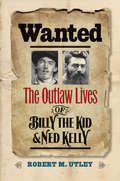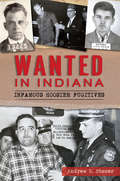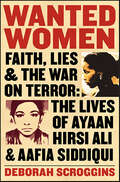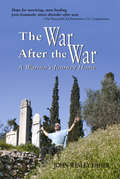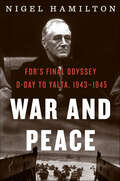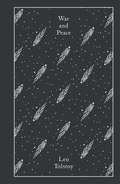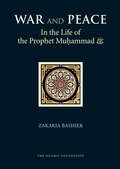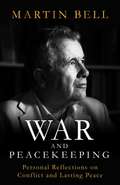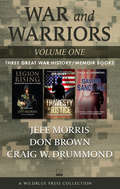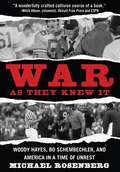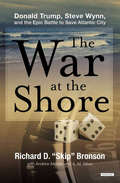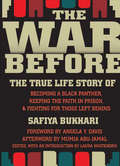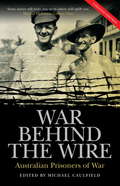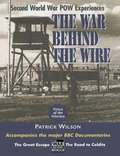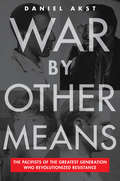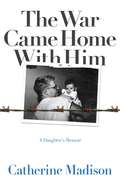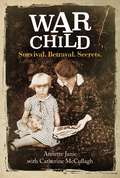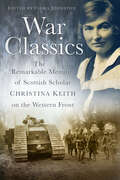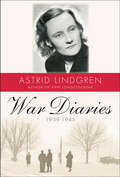- Table View
- List View
Wanted: The Outlaw Lives of Billy the Kid & Ned Kelly (The Lamar Series in Western History)
by Robert M. UtleyTwo famous 19th century outlaws from opposite sides of the world are brought to rollicking life in the acclaimed historian&’s &“marvelous dual biography&” (Douglas Brinkley, author of The Wilderness Warrior). The legendary exploits of Billy the Kid and Ned Kelly live on in the public imaginations of their respective countries, the United States and Australia. But the outlaws&’ reputations are so mythologized, the truth of their lives has become obscure. In Wanted, Robert M. Utley reveals the true stories and parallel courses of the two notorious contemporaries who lived by the gun, were executed while still in their twenties, and remain compelling figures in the folklore of their homelands. Utley draws sharp portraits of both young men, offering insightful comparisons of their lives and legacies. Billy was a fun-loving sharpshooter who excelled at escape and lived on the run after indictment for his role in the Lincoln Country War. While Ned, raised in the bush by his Irish convict father, was driven by outrage against British colonial authority to steal cattle and sheep, kill three policemen, and rob banks for the benefit of impoverished Irish sympathizers. Recounting their exploits, differences, and shared fates, Utley illuminates the worlds in which they lived on opposite sides of the globe. &“Robert M. Utley displays the gifts that have made him a storied interpreter of the nineteenth-century west.&”—T. J. Stiles, Pulitzer Prize-winning author of The First Tycoon
Wanted in Indiana: Infamous Hoosier Fugitives (True Crime)
by Andrew E. StonerTo most Hoosiers, John Dillinger is the very picture of an Indiana fugitive, but the state has seen many fascinating criminal characters on the run. In Tippecanoe County, two Lafayette youths murdered the sheriff's deputies transporting them to prison. The gun-toting "Elwood gun girl" walked from the headlines into legend. One fugitive passed himself off as a small-town cop while on the run, and a well-spoken Indiana killer became the first fugitive captured as a direct result of the TV show America's Most Wanted. Veteran true crime author Andrew E. Stoner examines not only the trail of destruction criminals have left in their wake but also their lives on the run.
Wanted Women: Faith, Lies, and the War on Terror: The Lives of Ayaan Hirsi Ali and Aafia Siddiqui
by Deborah ScrogginsThe author of Emma’s War offers a compelling account of the link between Muslim women’s rights, Islamist opposition to the West, and the Global War on Terror.Wanted Women explores the experiences of two fascinating female champions from opposing sides of the conflict: Islam critic Ayaan Hirsi Ali and neuroscientist Aafia Siddiqui. With Emma’s War: An Aid Worker, A Warlord, Radical Islam and the Politics of Oil, journalist Deborah Scroggins achieved major international acclaim; now, in Wanted Women, Scroggins again exposes a crucial untold story from the center of an ongoing ideological war—laying bare the sexual and cultural stereotypes embraced by both sides of a conflict that threatens to engulf the world.
WAR
by Sebastian JungerIn his breakout bestseller, The Perfect Storm, Sebastian Junger created "a wild ride that brilliantly captures the awesome power of the raging sea and the often futile attempts of humans to withstand it" (Los Angeles Times Book Review). Now, Junger turns his brilliant and empathetic eye to the reality of combat--the fear, the honor, and the trust among men in an extreme situation whose survival depends on their absolute commitment to one another. His on-the-ground account follows a single platoon through a 15-month tour of duty in the most dangerous outpost in Afghanistan's Korengal Valley. Through the experiences of these young men at war, he shows what it means to fight, to serve, and to face down mortal danger on a daily basis.
War
by Bob WoodwardTwo-time Pulitzer Prize winner Bob Woodward tells the revelatory, behind-the-scenes story of three wars—Ukraine, the Middle East and the struggle for the American Presidency. War is an intimate and sweeping account of one of the most tumultuous periods in presidential politics and American history. We see President Joe Biden and his top advisers in tense conversations with Russian president Vladimir Putin, Israeli prime minister Benjamin Netanyahu and Ukrainian president Volodymyr Zelensky. We also see Donald Trump, conducting a shadow presidency and seeking to regain political power. With unrivaled, inside-the-room reporting, Woodward shows President Biden&’s approach to managing the war in Ukraine, the most significant land war in Europe since World War II, and his tortured path to contain the bloody Middle East conflict between Israel and the terrorist group Hamas. Woodward reveals the extraordinary complexity and consequence of wartime back-channel diplomacy and decision-making to deter the use of nuclear weapons and a rapid slide into World War III. The raw cage-fight of politics accelerates as Americans prepare to vote in 2024, starting between President Biden and Trump, and ending with the unexpected elevation of Vice President Kamala Harris as the Democratic nominee for president. War provides an unvarnished examination of the vice president as she tries to embrace the Biden legacy and policies while beginning to chart a path of her own as a presidential candidate. Woodward&’s reporting once again sets the standard for journalism at its most authoritative and illuminating.
The War After the War: A Warrior's Journey Home
by John Wesley FisherThe War After the War maps the author's 37 year journey from his tour in Vietnam to the recovery of peace within his soul.
The War Against Tuberculosis: Samuel G. Dixon and the Rise of Modern Public Health in Pennsylvania (Keystone Books)
by James E. HigginsIn 1905, sanitary conditions in Pennsylvania were appalling. Thousands of children died of preventable and curable diseases, tens of thousands in the coal regions hacked themselves to death from black lung disease, and pollution in the commonwealth’s water killed tens of thousands more. In the wake of an alarming typhoid outbreak in Butler, the Pennsylvania legislature formed a modern state department of health. At its head was Samuel G. Dixon, who would rise to fame as one of the most respected public health experts of his day.While the legislation that created Pennsylvania’s department of health cleared space for its aggressive action, it was Dixon’s deft political touch and keen insight that enabled the department to avoid destruction at the hands of a people notoriously hostile to government encroachment. As commissioner, Dixon constructed the world’s largest, most sophisticated system of tuberculosis controls, with thousands of beds in three great sanatoria. As his reputation grew, Dixon was recognized as one of the nation’s greatest public health reformers and a champion of technology as the answer to great societal problems. At the same time, Dixon was a eugenicist who helped author a marriage law prohibiting unions between the diseased, those with intellectual disabilities or psychiatric disorders, alcoholics, and the “unfit.”This compelling history of Pennsylvania’s first commissioner of public health provides a fascinating view into the changes wrought by germ theory and the public health efforts that stemmed from it during the Progressive Era in the United States.
War and Peace: FDR's Final Odyssey: D-Day to Yalta, 1943–1945 (FDR at War #3)
by Nigel HamiltonThe “gripping and powerfully argued” final volume in the acclaimed 3-part biography of FDR at war—proving that he was the key strategist of WWII (New York Times Book Review).Nigel Hamilton’s celebrated trilogy culminates with a story of triumph and tragedy. In the spring of 1944, FDR oversaw the historic success of the D-day landings he had championed, just as he was found to be mortally ill. Yet even in the face of his own mortality, Roosevelt was the architect of a victorious peace that he would not live to witness.Using hitherto unpublished documents and interviews, Hamilton rewrites the famous account of World War II strategy given by Winston Churchill in his memoirs. Seventy-five years after the D-day landings we finally get to see, close-up and in dramatic detail, who was responsible for rescuing, and insisting upon, the great American-led invasion of France in June 1944, and why the invasion was led by Eisenhower. As FDR’s D-day triumph turns to personal tragedy, we watch the course of the disease, and how the dying president attempted—at Hawaii, Quebec, and Yalta—to prepare the United Nations for an American-backed postwar world order. Now we know: even on his deathbed, FDR was the war’s great visionary.“A first-class, lens-changing work.” —James N. Mattis, former US secretary of defense
War and Peace (Penguin Clothbound Classics)
by Leo TolstoyAt a glittering society party in St. Petersburg in 1805, conversations are dominated by the prospect of war. Terror swiftly engulfs the country as Napoleon’s army marches on Russia, and the lives of three young people are changed forever. The stories of quixotic Pierre, cynical Andrey, and impetuous Natasha interweave with a huge cast, from aristocrats and peasants, to soldiers and Napoleon himself. In War and Peace, Tolstoy entwines grand themes—conflict and love, birth and death, free will and fate—with unforgettable scenes of nineteenth-century Russia, to create a magnificent epic of human life in all its imperfection and grandeur.
War and Peace in the Life of the Prophet Muhammad
by Zakaria BashierBy analyzing the Prophet's conduct in war and his measures for ensuring peace the misperception that Islam is inextricably linked with violence can be allayed. The major battles in the early history of Islam are studied in the wider context of Islamic teachings on war and peace, as are the Qur'anic verses which allow Muslims to wage war, if necessary.
War and Peacekeeping: Personal Reflections on Conflict and Lasting Peace
by Martin BellThere are no winners in war, only losers. We have so far avoided a third world war, but across the globe regional conflicts flare up in a seemingly unstoppable cycle. Who can stand between the armed camps? Over six decades, Martin Bell has stood in eighteen war zones – as a soldier, a reporter and a UNICEF ambassador. Now he looks back on our efforts to keep the peace since the end of the Second World War and the birth of the United Nations peacekeeping mission in the new State of Israel. From the failures of Bosnia, Rwanda and South Sudan to nationalism&’s resurgence and the distribution of alternative facts across a darkening political landscape, Bell calls for us to learn from past mistakes – before it&’s too late.
War and Warriors Volume One: Legion Rising, Travesty of Justice, Saving Sandoval (War and Warriors #1)
by Jeff Morris Don Brown Craig W. DrummondThree real-life accounts of the struggles of American soldiers from the Iraq and Afghanistan battlefields to, in two cases, US military tribunals. Legion Rising: Surviving Combat and the Scars It Left Behind by Jeff Morris Follow Jeff through up-close, fast-paced accounts of the thrills and dangers of combat as a Platoon Leader in Iraq. Feel the weight of the gruesome and tragic loss of eight men whose lives were taken in the line of duty. Journey through his battle to face the scars and shadows that followed him long after his time serving in the military was over. Travesty of Justice: The Shocking Prosecution of Lt. Clint Lorance by Don BrownThe Book That Won a Presidential Pardon! On July 2, 2012, three Afghan males crowded on a motorcycle and sped down a Taliban-controlled dirt road toward Lt. Clint Lorance&’s men. In a split-second decision, Lorance ordered his men to fire. When no weapons were found on the Afghan bodies, the Army prosecuted Lorance for murder. &“The most powerful case to date for the exoneration of imprisoned Army Lt. Clint Lorance.&” —Sun-Sentinel Saving Sandoval by Craig W. Drummond While deployed in Iraq, Sandoval, an airborne infantryman and elite sniper, was instructed to &“take the shot&” and kill an enemy insurgent wearing civilian clothes. Two weeks later, Army Criminal Investigation Command descended upon Sandoval&’s unit, trying to link Sandoval and others to war crimes, including murder. &“A revealing, real-life courtroom drama, reminiscent of A Few Good Men.&” —Hunter R. Clark, International Law and Human Rights Program and Drake University Law School
War as They Knew It: Woody Hayes, Bo Schembechler, and America in a Time of Unrest
by Michael Rosenberg[From the front flap] The Vietnam War . . . Nixon . . . Kent State . . . The late 1960s and early 1970s were a time of total turmoil in America-the country was being torn apart by a war most people didn't support, young men were being taken away by the draft, and racial tensions were high. Nowhere was this turmoil more evident than on college campuses, the epicenters of the protest movement. The uncertain times presented a challenge to two of the greatest football coaches of all time. Woody Hayes, the legendary arch-conservative coach of Ohio State, feared for the future of America. His protege and rival, Bo Schembechler of the University of Michigan, didn't want to be bothered by these "distractions." Hayes worshipped General George S. Patton and was friends with President Richard Nixon. Schembechler befriended President Gerald Ford, a former captain and team MVP for the Wolverines. In this enthralling book, Michael Rosenberg dramatically weaves the campus unrest and political upheaval into the story of Hayes and Schembechler.
The War at Home: A Memoir
by Rachel StarnesWhen she fell in love with her brother's best friend, Rachel Starnes had no idea she was about to repeat a painful family pattern--marrying a man who leaves regularly and for long stretches to work a dangerous job far from home. Through constant relocations, separations, and the crippling doubts of early parenthood, Starnes effortlessly weaves together strands from her past with the relentless pace of Navy life in a time of war. Searingly honest and emotionally unflinching--and at times laugh out loud funny--Starnes eloquently evokes the challenges she faces in trying to find and claim a sense of home while struggling to chart a new path and avoid passing on the same legacy to her two young sons. At once a portrait of the devastating strains that military life puts on families and a meditation on what it means to be left behind, The War at Home is a brave portrait of a modern military family and the realities of separation, endurance, and love that overcomes. Praise for The War at Home:"Rachel Starnes's The War at Home navigates the joys, fears, compromises, and casualties that create the terrain of marriage. And if you are a military spouse, her memoir will reveal thoughts you never even knew you had. This is a wise and fearless book." --Siobhan Fallon, author of You Know When the Men Are Gone "One of the most honest and genuine memoirs I've ever read, as well as one of the most finely written. There's not a false note in these pages. Rachel Starnes's story is at once both singular and emblematic. . . . The War at Home is that rare thing: a book about the here and now that promises to last well beyond next month or next year." --Steve Yarbrough, award-winning author of The Realm of Last Chances and Safe from the NeighborsFrom the Trade Paperback edition.
The War at the Shore: Donald Trump, Steve Wynn, and the Epic Battle to Save Atlantic City
by Richard D. Bronson Andrew Meisler A. M. Silver“With Trump and Wynn, Skip Bronson nails the drama and muscle of a Super Bowl Sunday . . . A manual of strategy and tactics, smeared with sweat and blood” (Steve Tisch, chairman of the New York Giants). From 1995 to 2000, two of the world’s best-known companies―Mirage Resorts and Trump Resorts―run by two of the most flamboyant businessmen of our time, fought a bare-knuckled, high-stakes battle over a prime piece of real estate in one of America’s most famous resort towns. No money was spared, no punch was pulled, no invective went unhurled in what became known as “The War at the Shore.” Now Bronson, who was a member of the board of directors of the Mirage and president of New City Development Company, the Mirage subsidiary whose primary purpose was to build a top-level new casino and hotel complex in Atlantic City, tells the inside story of this epic struggle. Along the way, Bronson weaves in fascinating and inspiring anecdotes from his complicated past. Gripping from beginning to end, The War at the Shore is a rare up-close look at the world of casino development and the essential modern chapter in the history of America’s “Boardwalk Empire.” “Two powerful personalities clash in this first-hand account of Steve Wynn’s bid to open a new casino on Donald Trump’s turf. . . . An engaging insider’s account of the down-and-dirty machinations that go into high-stakes real estate development.” —Kirkus Reviews “Marked by casinos, boardrooms, and double-dealings, Bronson’s account is a vivid portrayal of Atlantic City’s revitalization.” —LA Confidential “What an amazing backstage look into the world of casinos, moguls and politics.” —Peter Morton, chairman & founder of Hard Rock Hotel & Casino and Hard Rock Cafes
The War Before: The True Life Story of Becoming a Black Panther, Keeping the Faith in Prison & Fighting for Those Left Behind
by Safiya BukhariAn inspiring memoir from a legendary activist and political prisoner that &“reminds us of the sheer joy that comes from resisting civic wrongs&” (Truthout). In 1968, Safiya Bukhari witnessed an NYPD officer harassing a Black Panther for selling the organization&’s newspaper on a Harlem street corner. The young pre-med student felt compelled to intervene in defense of the Panther&’s First Amendment right; she ended up handcuffed and thrown into the back of a police car. The War Before traces Bukhari&’s lifelong commitment as an advocate for the rights of the oppressed. Following her journey from middle-class student to Black Panther to political prisoner, these writings provide an intimate view of a woman wrestling with the issues of her time—the troubled legacy of the Panthers, misogyny in the movement, her decision to convert to Islam, the incarceration of outspoken radicals, and the families left behind. Her account unfolds with immediacy and passion, showing how the struggles of social justice movements of the past have paved the way for the progress—and continued struggle—of today. With a preface by Bukhari&’s daughter, Wonda Jones, a forward by Angela Y. Davis, and edited by Laura Whitehorn, The War Before is a riveting look at the making of an activist and the legacy she left behind.
War Behind the Wire: Australian Prisoners of War
by Michael CaulfieldMichael Caulfield presents accounts of Australian prisoners of war, capturing the Aussie spirit that manages to endure through all.
The War Behind the Wire: Second World War POW Experiences (Voices of the Veterans)
by Patrick WilsonPublished to coincide with the major 2 part BBC1 series (Autumn 2000) of the same name, War Behind the Wire focuses on the capture, interrogation, the comradeship of camp life, escape planning and forgery techniques, tunnelling, the thrill of life on the run, re-capture and punishment, the joy of liberation. All these experiences and more are vividly described by former POWs of the Second World War and their German camp guards, in War Behind the Wire.Through gripping first-hand accounts enhanced with numerous illustrations, we learn the true story of the ill-fated Great Escape, which ended in the barbaric murder of 50 gallant men of many nationalities. Former inmates tell what life in Colditz Castle was really like.War Behind the Wire is an inspiring book of memories and experiences of those who never gave up hope. These will be as unforgettable for the reader as they were for those who found themselves in captivity.
War By Other Means: The Pacifists of the Greatest Generation Who Revolutionized Resistance
by Daniel AkstPacifists who fought against the Second World War faced insurmountable odds—but their resistance, philosophy, and strategies fostered a tradition of activism that shaped America right up to the present day. <p><p>In this provocative and deeply researched work of history, Akst takes readers into the wild, heady, and uncertain times of America on the brink of a world war, following four fascinating resisters—four figures who would subsequently become famous political thinkers and activists—and their daring exploits: David Dellinger, Dorothy Day, Dwight MacDonald, and Bayard Rustin. The lives of these diverse anti-war advocates—a principled and passionate seminary student, a Catholic anarchist, a high-brow intellectual leftist, and an African-American pacifist and agitator—create the perfect prism through which to see World War II from a new angle, that of the opposition, as well as to show how great and lasting their achievements were. <p><p>The resisters did not stop the war, of course, but their impact would be felt for decades. Many of them went on to lead the civil-rights and anti-Vietnam War movements, the two most important social stands of the second half of the twentieth century. The various World War II resisters pioneered non-violent protest in America, popularized Gandhian principles, and desegregated the first prison mess halls. Theirs is a story that has never been told.
War by Other Means: A General in the Trump White House
by Keith KelloggGeneral Keith Kellogg saw it all. The only national security advisor to work side by side with both President Trump and Vice President Pence, he was their confidant as they made their most momentous decisions. No one knows better than he that the hysterical accusations of the administration&’s partisan detractors were unconnected to reality. Demolishing baseless caricatures of Donald Trump, General Kellogg provides one of the few reliable accounts of the administration from the earliest days of the 2016 campaign to the end of the president&’s term. Kellogg reveals: How Trump&’s &“America First&” policies strengthened the nation after Obama&’s eight-year apology tour Why the president&’s tough approach to China worked—and why future administrations must continue to take the China threat seriously How withdrawal from the Iran nuclear deal and the strike on General Soleimani slowed the spread of radical Islamist terror Why Democrats&’ appeasement policies are courting disaster for America and the world The radicals attacking President Trump&’s legacy are sacrificing sound policy to politics. Kellogg&’s account is an urgently needed reminder that politics is &“war by other means.&” Our enemies never forget that, and Americans forget it to their peril.
The War Came Home with Him: A Daughter's Memoir
by Catherine MadisonDuring his years as a POW in North Korea, &“Doc&” Boysen endured hardships he never intended to pass along, especially to his family. Men who refused to eat starved; his children would clean their plates. Men who were weak died; his children would develop character. They would also learn to fear their father, the hero. In a memoir at once harrowing and painfully poignant, Catherine Madison tells the stories of two survivors of one man&’s war: a father who withstood a prison camp&’s unspeakable inhumanity and a daughter who withstood the residual cruelty that came home with him.Doc Boysen died fifty years after his ordeal, his POW experience concealed to the end in a hidden cache of documents. In The War Came Home with Him, Madison pieces together the horrible tale these papers told—of a young captain in the U.S. Army Medical Corps captured in July 1950, beaten and forced to march without shoes or coat on icy trails through mountains to camps where North Korean and Chinese captors held him for more than three years. As the truth about her father&’s past unfolds, Madison returns to a childhood troubled by his secret torment to consider, in a new light, the telling moments in their complex relationship.Beginning at her father&’s deathbed, with all her questions still unspoken, and ending with their final conversation, Madison&’s dual memoir offers a powerful, intimate perspective on the suppressed grief and thwarted love that forever alter a family when a wounded soldier brings his war home.
War Child: Survival. Betrayal. Secrets.
by Annette Janic Catherine McCullaghWar Child is a true story that spans 100 years, revealing agonising choices against the backdrop of Nazi Germany, the lingering effects of war, the 1950s Australian migration experience, and a modern day search .. Magdalena (‘Leni’) is an illegitimate child born in a small town steeped in superstition in pre-World War II Germany. Denounced as a source of shame by her devoutly Catholic grandfather and the narrow-minded townspeople, Leni and her mother eke out a living dogged by poverty and prejudice in a country moving inexorably towards war. With the advance of the Red Army, Leni and her family are stripped of their possessions and forced to survive on their wits, transforming Leni from a meek, cowed girl to breadwinner and protector. She becomes a member of the Hitler youth, while at the same time puzzling over the disappearance of her Jewish friend. Forced to leave school at 14, Leni is confronted with the terrible choice of submitting to secret systematic rape by her employer, or having her mother interned. When she falls pregnant, she is determined to avoid the hardship she endured as a child and marries her Yugoslav boyfriend and migrates to Australia. It is an arduous journey marred by the appalling conditions at Bagnoli transit camp and the enormous difficulties of beginning a new life in Australia. In researching her mother’s life after the death of both parents, Leni’s daughter Annette makes a startling discovery. With her dying breath, Leni’s confidante reveals another secret. A complex search that crosses three continents follows as Annette gradually unravels the web of intrigue that protects her mother’s ultimate secret.
War Classics: The Remarkable Memoir of Scottish Scholar Christina Keith on the Western Front
by Flora JohnstonChristina Keith came from the small town of Thurso on the far north coast of Scotland. Highly intelligent and ambitious, she became a lecturer in Classics at a time when that was still a brave and unusual choice for a woman. Towards the end of the First World War she left behind the sheltered world of academia to live and work among soldiers of all social backgrounds as a lecturer with the Army’s education scheme in France. She writes with warmth and humour of her experiences. When she and a companion travel across the devastated battlefields, just a short time after the guns have fallen silent, her descriptions are both evocative and moving. This unique memoir is an unforgettable read.
War & Coffee: Confessions of an American Blackhawk Pilot in Afghanistan
by Joshua HavillReaders will gain insight into the experience of flying a Blackhawk in combat, including on special-operations missionsBeyond the action of combat, this work eloquently immerses the reader into life within walls of a US military base in Afghanistan Author Joshua Havill recounts his deployment with humility, candor, and humor that will make the story approachable and engaging to readers from any walk of life
War Diaries, 1939–1945
by Astrid LindgrenThese personal diaries by the author of Pippi Longstocking chronicle her experiences in Europe during WWII and her astute observations of the conflict.Before she became internationally known for her Pippi Longstocking books, Astrid Lindgren was an aspiring author living in Stockholm with her family at the outbreak of the Second World War. The diaries she kept throughout the hostilities offer her unique perspective—as a civilian, a mother, and an aspiring writer—on the devastating conflict. Lindgren emerges as a morally courageous critic of violence and war, as well as a deeply sensitive and keen observer of world affairs. We hear her thoughts about rationing, blackouts, the Soviet invasion of Finland, and the nature of evil, as well as of her personal heartbreaks, financial struggles, and trials as a mother and writer.Posthumously published in Sweden to great international acclaim, these diaries were called in the Swedish press an “unparalleled war narrative,” “unprecedented.” and a “shocking history lesson.” Illustrated with family photographs, newspaper clippings, and facsimile pages, Lindgren’s diaries provide an intensely personal and vivid account of Europe during the war.
